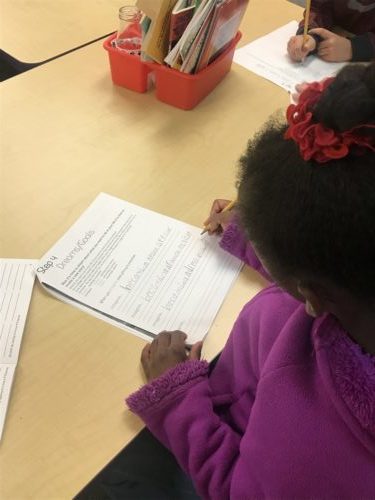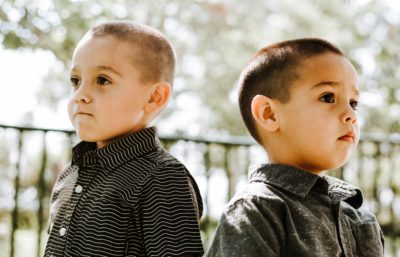
Little girl writing her Imagine story.
When teachers, counselors, admin, etc. use new curriculum/ideas in their school and classrooms, they like to know what they are using is backed by credible research. We have good news! Phase One of our research on The Imagine Project has come back significantly positive! If you aren’t familiar with The Imagine Project writing process, click here to see the free journals.
Until now The Imagine Project writing activity has been based on the plethora of research that’s been done on expressive writing over the last 25 years. In most of the studies, participants were asked to take 15 to 30 minutes to write about an emotionally challenging, stressful, even traumatic incident in their lives. Typically, they are asked to do this once a day for three to five days. Even though the time spent writing can be emotional and make the writer feel vulnerable, the long-term benefits are positive. Study measurements were done months, even years, after the writing exercises and positive results still existed.
Expressive writing research shows it can:
- improve grade point average,
- improve working memory,
- improve writing skills,
- decrease school dropout rates,
- enhance immune function (fewer illnesses and fewer trips to the doctor),
- decrease blood pressure,
- promote wound healing after surgery,
- decrease anxiety and depression,
- help people feel better about life, and
- lessen post-traumatic intrusion and avoidance symptoms.
We wanted to see more specifically how The Imagine Project affects a student who uses it. So we hired a well sought after research company called QREM (Quantitative Research Evaluation and Measurement) in Littleton, CO. QREM then designed extensively researched questionnaires for elementary, middle, and high school students looking at themes that included academic risk taking, outlook toward their future, positive school attitudes, stress management, support, and writing.
The research process took about 5 months to complete. We recruited various schools in Colorado and Washington. Students took a pretest ora posttest to minimize the test-retest effect. So students who took the pretest did not take the posttest and those who took the posttest had not taken the pretest. All did the Imagine Project writing activity steps 1-7 once in their classrooms. We tested 4th, 5th, 8th, and high school (from Alternative High Schools only because those were the students who were available at the time).
Our results were even stronger than we anticipated:
The Imagine Project has a substantial impact on middle school students.Middle school participants made more significant gains on the established constructs than any other age group. Specifically, middle school students made gains in their ability to manage their stress and their perception of support from others (increases of 11.5% and 6.3%, respectively).
Boys were especially receptive towards the Imagine Project.Boys of all age groups made substantial gains in many of the constructs –seeing improved attitudes towards school by 11.6%, their ability to manage stress by 9.8%, and their perceptions of support by 8.0%.
Girls improved with stress management.Middle and high school girls participating in the Imagine Project improved their overall stress management by 9.4%
Elementary School Findings showed gains in skills and comfort with writing. This information is backed by many teachers reporting their student’s love of writing increased after using The Imagine Project writing project. QREM researchers believe we did not see more changes in stress management with elementary school students because they are more difficult to measure due to being easily influenced by life events on a daily basis—and developmentally it can be challenging to measure these types of issues. But, teachers tell us all the time, the Imagine Project makes a huge impact in a student’s self-awareness, ability to cope with stress, improved kindness, and it brings classrooms together in support of each other.
We are very pleased with the results of our Phase One research project. We are now in Phase Two, looking more in-depth at constructs such as compassion, self-awareness, stress management, and love of writing. We understand how critical mental health and education research is to implementation of programs in a classroom/school, and we want to know the best format for applying the Imagine Project writing process. With kids as stressed as they our in our world, they (and you) need tools for support. Go to www.theimagineproject.org to download our free journals!
I hope you find this helpful and spread the word about The Imagine Project!
Thank you,
Dianne
The Imagine Project, Inc., a nonprofit organization that helps kids, teens, and adults overcome challenging life circumstances through expressive writing. Dianne is a thought leader in the area of stress and trauma in children. Her simple, yet profound 7-step writing tool, now used by schools across the US, gives kids and teens the opportunity to rewrite a challenging personal story and Imagine new possibilities in its place.

 A very important question all parents, teachers, counselors, youth leaders, etc. must always be asking is, “How do we teach our kids to be resilient?” Resilience is so important when trying to navigate and succeed in our complicated world. Research shows stress is growing with our younger generations. Social media, faster moving information, pressures from peers, parents, and education is intensifying quickly. Knowing how to teach our kids to cope with life and become resilient is critical to their ability to overcome stress and become resilient in their lives.
A very important question all parents, teachers, counselors, youth leaders, etc. must always be asking is, “How do we teach our kids to be resilient?” Resilience is so important when trying to navigate and succeed in our complicated world. Research shows stress is growing with our younger generations. Social media, faster moving information, pressures from peers, parents, and education is intensifying quickly. Knowing how to teach our kids to cope with life and become resilient is critical to their ability to overcome stress and become resilient in their lives. Laughter, running, jumping, being silly, twirling, smiling, creating—all are part of play and having fun! Instinctively, as parents and teachers, we know the importance of play for our kids (and ourselves)—it gives them/us a welcome break from stress and promotes mental health. Yet, we often put play last after homework, sports, jobs, and the constant daily routines of life. The American Academy of Pediatrics promotes play as essential to a child’s development because research shows that it improves learning, cognitive awareness, physical, social, and emotional wellbeing. Fortunately, play is making a comeback because we are remembering how critical it is to healthy brain and body development. Play gives kids tremendous learning opportunities, including how to work with others, manage feelings, think, plan, make decisions, and read other people’s emotions. Play also promotes physical fitness, creativity, self-expression, self-regulation, and healthy boundaries—basically physical and emotional wellness and mental health!
Laughter, running, jumping, being silly, twirling, smiling, creating—all are part of play and having fun! Instinctively, as parents and teachers, we know the importance of play for our kids (and ourselves)—it gives them/us a welcome break from stress and promotes mental health. Yet, we often put play last after homework, sports, jobs, and the constant daily routines of life. The American Academy of Pediatrics promotes play as essential to a child’s development because research shows that it improves learning, cognitive awareness, physical, social, and emotional wellbeing. Fortunately, play is making a comeback because we are remembering how critical it is to healthy brain and body development. Play gives kids tremendous learning opportunities, including how to work with others, manage feelings, think, plan, make decisions, and read other people’s emotions. Play also promotes physical fitness, creativity, self-expression, self-regulation, and healthy boundaries—basically physical and emotional wellness and mental health! Unfortunately, we live in a world where trauma happens. It might be a school shooting, a natural disaster, or a significant loss of a student, teacher, or admin, but it happens more often that we’d like. I recently sat in with a classroom of 4thgraders who lost a fellow schoolmate to a fatal disease—a significant school trauma. Their journey in understanding what happened is complicated, but I was grateful to be there to help them through it using The Imagine Project.
Unfortunately, we live in a world where trauma happens. It might be a school shooting, a natural disaster, or a significant loss of a student, teacher, or admin, but it happens more often that we’d like. I recently sat in with a classroom of 4thgraders who lost a fellow schoolmate to a fatal disease—a significant school trauma. Their journey in understanding what happened is complicated, but I was grateful to be there to help them through it using The Imagine Project. With the holidays comes family, fun, and gifts! There’s no better time of year to each a child (and adults) the importance of gratitude beyond the “Thank you” that comes after receiving a gift. Daily gratitude is such a simple idea/process, yet most people overlook it’s amazing benefits. Dr. David Hamilton, author of Why Kindness is Good for You, writes, “Gratitude is a mark of being kind to life by being aware of all that is around us, and when we are grateful, we acknowledge the people and situations in our life and express thanks for them.” We teach our children to say “thank you,” but it’s also important to model and teach them to see gratitude as a key philosophy of life. Seeing and feeling gratitude every day is one key to being resilient and successful.
With the holidays comes family, fun, and gifts! There’s no better time of year to each a child (and adults) the importance of gratitude beyond the “Thank you” that comes after receiving a gift. Daily gratitude is such a simple idea/process, yet most people overlook it’s amazing benefits. Dr. David Hamilton, author of Why Kindness is Good for You, writes, “Gratitude is a mark of being kind to life by being aware of all that is around us, and when we are grateful, we acknowledge the people and situations in our life and express thanks for them.” We teach our children to say “thank you,” but it’s also important to model and teach them to see gratitude as a key philosophy of life. Seeing and feeling gratitude every day is one key to being resilient and successful. Stress is a normal, unavoidable part of life. It’s actually good for a child to experience small amounts of manageable stress, such as frustration with learning a new skill, dealing with being late to a birthday party due to traffic, or worrying about saying the wrong line in a school play. Learning to deal with the minors stressors of life as a child, when a parent is around to teach them healthy coping skills, will support them as they grow and face more difficult life challenges.
Stress is a normal, unavoidable part of life. It’s actually good for a child to experience small amounts of manageable stress, such as frustration with learning a new skill, dealing with being late to a birthday party due to traffic, or worrying about saying the wrong line in a school play. Learning to deal with the minors stressors of life as a child, when a parent is around to teach them healthy coping skills, will support them as they grow and face more difficult life challenges.

